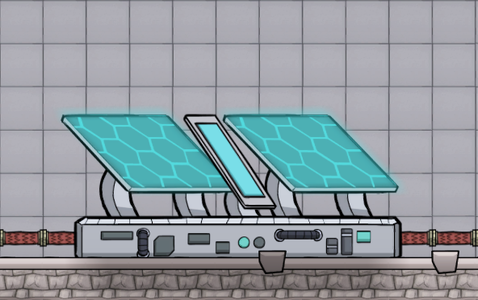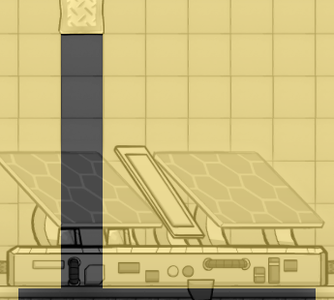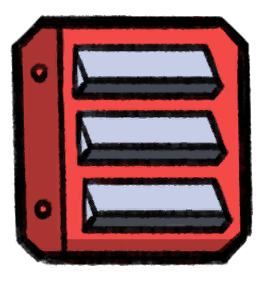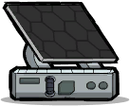Solar Panel
Solar Panel is a building that can convert light into power. The more light it receives, the more power it generates. 380 W is the maximum power it can generate, and it has to have a total Lux coverage of 350 000 (7 tiles * 50 000 on each tile). Covering a tile will cause less power to generate as the power generated is based on total Lux received. Requires more Lux per tile to reach full output (6 tiles * ~58 000)
It has two separate panels and one panel is three tiles wide, however they have no effect on the functionality.
The "floor" of the panel is a solid so Duplicants can walk on it and it will keep gas from escaping into space.
Usage
While their mechanics are straightforward, in the base game, using Solar Panels requires heavy investment in infrastructure.
Solar Panels cannot withstand Meteor strikes, overheat as easily as generic buildings, and there is no building materials that could mitigate it. This means they have to be protected both from direct damage and hot materials falling on them.
- Transparent tiles, such as Window, Airflow or Mesh can be used to separate hot Regolith from Solar Panels. However by themselves they cannot withstand Meteor hits either and will require a lot of manual labor and constant material investment to regularly break up solid Regolith tiles and fix accumulated damage.
- Window Tiles also partially block light, reducing Solar Panel's efficiency by about 10%. They also soak heat from regolith and might transfer it to machinery.
- Robo-Miners can help with regolith dismantling, but will require cooling and protection themselves.
- Bunker Doors can serve as reliable upper line of defense, but they require automation setup involving Space Scanners, which are complicated by themselves.
Meteor storms also decrease the amount of solar power generated each cycle, because either accumulated regolith tiles or closed Bunker Doors will block panels from receiving light. Badly timed meteor shower can block almost an entire cycle's worth of sunlight.
The second issue with solar power is its cyclical nature. If there are no other power sources to use as backup, each Solar Panel would need 9 Smart Batteries or 5 Jumbo Batteries to compensate for the worst-case downtime. More on Solar output.[confirmation?]
Mechanics
The power generated by a solar panel scales linearly with the total illuminance (in lux) incident across its tiles. The total lux that falls on a solar panel is the sum of the lux incident on each of the panel's tiles, for example a lux of 10,000 on each of the solar panel's 7 tiles sums to a total illuminance of 70,000 lux (10,000 lux/tile * 7 tiles).
Maximum output of 380 W requires a total lux of 350,000. Therefore, the power output of a solar panel can be computed as a function of total lux:
Where is the power produced by the solar panel, and is the total illuminance (in lux) incident on the solar panel.
Illuminance from sunlight throughout a cycle
The day-night cycle results in a varying intensity of sunlight, ranging from 0 lux at night to a peak of 80,000 lux at midday (see Light). The illuminance on a single tile from sunlight at any given time in a 600 second cycle can be determined by the following:
Where is the illuminance (in lux) that falls on each tile from sunlight, and is the time of day in seconds, ranging from 0 to 600 for each cycle.
Average power across a cycle using sunlight
For a solar panel in unobstructed direct sunlight (e.g. in the vacuum of space with no light-blockers above it), its power output will vary as solar illuminance changes with the cycle.
- At night, solar panels produce no power.
- During the morning, solar panels ramp up power until solar illuminance reaches 50,000 lux, at which point the maximum output of 380 W is reached.
- Solar illuminance continues to rise to a peak of 80,000 lux at midday, but solar panels will continue to produce their maximum output of 380 W.
- Solar illuminance begins dropping after midday. Once illuminance drops below 50,000 lux, the power produced by solar panels begins to ramp down until nighttime.
This assumes no interruption in solar illumination due to meteor showers, which is the default case in the ![]() Spaced Out DLC.
Spaced Out DLC.
Combining the above two formulae, this process can be modeled with the following to compute the power generated for a given time of day:
Integrating with respect to time , the total energy in joules produced by a solar panel in a single cycle can be found:
Given that each cycle lasts 600 seconds, this gives an average power output of ~264 W across a cycle for a single solar panel with an unobstructed view of space.
 Common averages
Common averages
In the Spaced Out DLC, peak sunlight varies depending on the type of asteroid. Here is a list of common values found throughout clusters.
| Peak sunlight | Solar Panel
average output |
|---|---|
| 10,000 lux | 42.3 W |
| 20,000 lux | 84.7 W |
| 30,000 lux | 127 W |
| 35.000 lux | 148.2 W |
| 40,000 lux | 169.3 W |
| 50,000 lux | 211.7W |
| 60,000 lux | 237.6 W |
| 80,000 lux | 263.9 W |
| 100,000 lux | 278.4 W |
| 120,000 lux | 287.7 W |
Determining storage capacity to last the night
A grid containing both solar panels and fuel-based electricity can automate the power generators using Smart Batteries to save fuel. This allows solar power to be fully integrated with very little energy storage.
If no other form of energy generation is present, then to provide a constant 264 W of power per solar panel throughout an entire cycle, power must be stored during the day so it can be released during the night when solar power production stops.
The total energy storage required (in joules) is equal to the excess energy generated during the day beyond the 264 W average. Or, equivalently, it is equal to the deficit of solar energy below the average 264 W due to the late evening / night / early morning when solar power production drops.
To compute the energy generated during the day in excess of the 264 W average, it is sufficient to consider the energy generated within the average 264 W envelope, and subtract it from the total energy generated during the cycle.
Substituting this in, gives:
And subtracting from the total power gives:
That is, for a single solar panel with a constant unobstructed view of space, you need 39.3 kJ of energy storage to store enough energy to supply a constant 264 W throughout the cycle. Accounting for battery runoff, this is very close to the storage provided by two Smart Batteries, or (less optimally) one Jumbo Battery.
How many batteries do I need?
- In the
 Spaced Out DLC, most asteroids do not experience meteor showers. Therefore, solar panels can achieve an unobstructed view of space 100% of the time. In this case, two Smart Batteries or one Jumbo Battery per solar panel should be approximately sufficient to provide a constant supply of power, even throughout the night.
Spaced Out DLC, most asteroids do not experience meteor showers. Therefore, solar panels can achieve an unobstructed view of space 100% of the time. In this case, two Smart Batteries or one Jumbo Battery per solar panel should be approximately sufficient to provide a constant supply of power, even throughout the night. - In the base game, an unlucky meteor shower can block off access to space for an entire cycle or more. To account for a worst-case scenario (i.e. having to store an entire cycle's worth of solar power), you will need a storage capacity of at least 158 kJ per solar panel. Accounting for battery runoff, this is equivalent to 9 Smart Batteries or 5 Jumbo Batteries.
- In both cases, these calculations assume an unobstructed view of space. In cases where solar panels are partially blocked (for example if vertically overlapping solar panels to maximize efficiency) you may need greater or fewer batteries to compensate, depending on the level of obstruction.
Tips
- Solar Panels can convert Shine Bugs light into electricity as well, although this only gives about 8-10W per Shine Bug, and only when they are very close to the Solar Panel. This can be used for Shine Bug Reactors.
- Because sunlight isn't constant, a optimal solar panel placed in the sun over the course of one cycle will generate ~264W on average.
 In the Spaced Out DLC, Solar Panels can be used for easy, free power due to the DLC's lack of Meteors on most planetoids, once the according material science is done. However, the player must also take into account the max lux level for each planetoid in Spaced Out, as Lux level varies from planetoid to planetoid. Also, the Regolith Planetoid has meteor showers, that can stop solar panels from functioning. Many of the DLC's POI have deconstructable Window Tiles to easily get the required Glass for construction. The Orbital Cargo Module can be used to transport 600 kg of Glass to a Planetoid without a Rocket Platform, allowing a new colony to build 3 solar panels right off the bat.
In the Spaced Out DLC, Solar Panels can be used for easy, free power due to the DLC's lack of Meteors on most planetoids, once the according material science is done. However, the player must also take into account the max lux level for each planetoid in Spaced Out, as Lux level varies from planetoid to planetoid. Also, the Regolith Planetoid has meteor showers, that can stop solar panels from functioning. Many of the DLC's POI have deconstructable Window Tiles to easily get the required Glass for construction. The Orbital Cargo Module can be used to transport 600 kg of Glass to a Planetoid without a Rocket Platform, allowing a new colony to build 3 solar panels right off the bat.- Solar Panels cannot get tune ups from the Power Control Station.
Gallery
History
- U50-582745: Fixed missing glass string Solar Panel database entry.









































